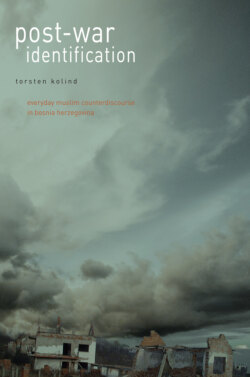Читать книгу Post-War Identification - Torsten Kolind - Страница 12
На сайте Литреса книга снята с продажи.
The structure of the book
ОглавлениеPart I, Framing the question, consists of the Prologue, with factual information about war and post-war episodes in the Stolac area. Chapter 1 presents a thorough reading of contemporary anthropological perspectives on war and warrelated violence, and my own research is placed in relation to this. In Chapter 2, I depict the way in which my informants’ world has been unmade: primarily through ontological insecurity, the breakdown of mental categories, moral decay, and an all-pervading feeling of loss. Chapter 3 outlines the theoretical tools for analysing identification, discourse and counterdiscourse; the delicate balance is to establish the concept of counterdiscourse solidly enough for it to function as an analytical tool, and porously enough to avoid doing violence to the ambiguities of real life.
Part II, Who are they, the ones who did this to us? is about how the Muslims of Stolac identify possible Others when accounting for the war as well as for their present hopeless situation. My main argument is that their identifications of the Others resist the ethnicisation that came to dominate public life in former Yugoslavia and in the seceding nations. Chapter 4, therefore, outlines the emergence of this national thinking in former Yugoslavia, showing how it is rooted in the post-Second-World-War politics of Tito, but exploded throughout the 1980s as a way to gain power. Chapters 5, 6, 7 and 8 present the most important categories of identity which my informants employ when identifying the guilty party: immoral politics; decent and indecent people; un-cultured persons, and, lastly, a complex range of different ways of categorising Croats (my informants’ main ethnic Other). All identifications avoid ethnifying the war and are part of the Muslims’ counterdiscourse.
Part III, Who are we, since this was done to us? deals with my informants’ identification of themselves as Muslims, an identity that has become increasingly important. Pre-war embedded practices of identification no longer suffice, so new and more conscious values have to be attached to their ethnoreligious identity. When identifying Muslimness, my informants avoid drawing upon the national and religious values promoted especially by Bosnian Muslim political elite throughout the war. Chapter 9, which should be read in continuation of Chapter 4, accounts for the emergence of this specific Bosnian Muslim national religious identity; and I argue that it came late, was contradictory, and can to some extent be seen as an elite project. In Chapter 10, I outline the features of pre-war processes of everyday Bosnian Muslim ethnoreligious identification. I find it reasonable to conclude that this identification was very important, but also embedded in everyday life and characterised by respectful means of inter-ethnic interaction. This insight is important later when I demonstrate how my informants have objectified elements of such pre-war habitual patterns of inter-ethnic interaction today, and when I estimate the changes that the war has created in matters of identification. Chapter 11 illustrates how national and religious identification is only of minor importance to the Muslims of Stolac. Chapters 12, 13, 14 and 15 present the most important categories of identities which my informants employ when identifying themselves: a strong local patriotic attachment that includes all respectable citizens of Stolac; an ideal of tolerance and inter-ethnic coexistence; shifting attachments to the discursive construct of Europe-Balkan; and the ‘role of the victim.’ The first three resist the nationalist thinking to various degrees. For my informants, their Muslim identity is of utmost importance; however, the content of this identity relates not to nationalist or religious elements, but to values stressing interethnic respect and coexistence. Only in the ‘role of the victim’ have I found elements of an antagonist, essentialist ethnic identity.
